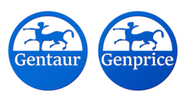Description
HER2 / ErbB2 Antibody | 13-138 | Gentaur UK, US & Europe Distribution
Host: Rabbit
Reactivity: Human
Homology: N/A
Immunogen: A synthetic peptide of human HER2 / ErbB2
Research Area: Cancer, Cell Cycle, Growth Factors, Immunology, Signal Transduction
Tested Application: WB, IHC, IF, Flow
Application: WB: 1:500 - 1:1000
IHC: 1:50 - 1:200
IF: 1:20 - 1:50
Flow: 1:20 - 1:50
Specificiy: N/A
Positive Control 1: HeLa
Positive Control 2: N/A
Positive Control 3: N/A
Positive Control 4: N/A
Positive Control 5: N/A
Positive Control 6: N/A
Molecular Weight: Observed: 190kDa
Validation: N/A
Isoform: N/A
Purification: Affinity purification
Clonality: Polyclonal
Clone: N/A
Isotype: IgG
Conjugate: Unconjugated
Physical State: Liquid
Buffer: PBS with 0.02% sodium azide, pH7.3.
Concentration: N/A
Storage Condition: Store at 4˚C. Avoid freeze / thaw cycles.
Alternate Name: erbB-2 Antibody: NEU, NGL, HER2, TKR1, CD340, HER-2, MLN 19, HER-2/neu, MLN19, NEU, Receptor tyrosine-protein kinase erbB-2, Metastatic lymph node gene 19 protein
User Note: Optimal dilutions for each application to be determined by the researcher.
BACKGROUND: This gene encodes a member of the epidermal growth factor (EGF) receptor family of receptor tyrosine kinases. This protein has no ligand binding domain of its own and therefore cannot bind growth factors. However, it does bind tightly to other ligand-bound EGF receptor family members to form a heterodimer, stabilizing ligand binding and enhancing kinase-mediated activation of downstream signalling pathways, such as those involving mitogen-activated protein kinase and phosphatidylinositol-3 kinase. Allelic variations at amino acid positions 654 and 655 of isoform a (positions 624 and 625 of isoform b) have been reported, with the most common allele, Ile654/Ile655, shown here. Amplification and/or overexpression of this gene has been reported in numerous cancers, including breast and ovarian tumors. Alternative splicing results in several additional transcript variants, some encoding different isoforms and others that have not been fully characterized.






